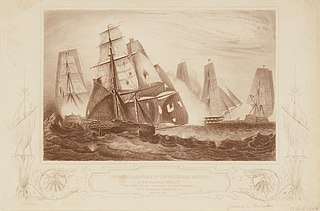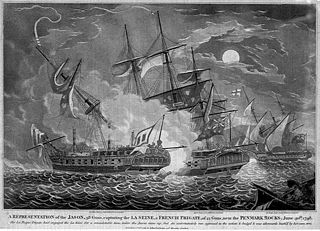
Didon was a Virginie-class 40-gun frigate of the French Navy. Captured by the British in 1805, she went on to serve briefly in the Royal Navy as the 38-gun fifth-rate HMS Didon until she was sold in 1810.

D'Hautpoul was a Téméraire class 74-gun French Navy ship of the line launched at Lorient on 2 September 1807. She was previously named Alcide and Courageux.

HMS Fisgard was a 46-gun fifth rate Leda-class frigate of the Royal Navy. She spent sixty years in service on a variety of duties.

James Richard Dacres was an officer of the Royal Navy who saw service during the Seven Years' War, the American War of Independence and the French Revolutionary and Napoleonic Wars. He eventually rose to the rank of Vice-Admiral.

HMS Castor was a 32-gun Amazon-class fifth-rate frigate of the Royal Navy. She served during the French Revolutionary and Napoleonic Wars. The French briefly captured her during the Atlantic Campaign of May 1794 but she spent just 20 days in French hands as a British ship retook her before her prize crew could reach a French port. Castor eventually saw service in many of the theatres of the wars, spending time in the waters off the British Isles, in the Mediterranean and Atlantic, as well as the Caribbean.

HMS Jason was a 38-gun Artois-class fifth-rate frigate of the Royal Navy. She served during the French Revolutionary Wars, but her career came to an end after just four years in service when she struck an uncharted rock off Brest and sank on 13 October 1798. She had already had an eventful career, and was involved in several engagements with French vessels.

HMS Vengeance was originally the 48-gun French Navy frigate Vengeance and lead ship of her class. She engaged USS Constellation during the Quasi-War, in an inconclusive engagement that left both ships heavily damaged. During the French Revolutionary Wars, HMS Seine hunted Vengeance down and captured her after a sharp action. She was recommissioned in the Royal Navy as the 38-gun fifth rate HMS Vengeance, but the British apparently never returned her to seagoing service. Accounts are divided as to her eventual fate. She may have been broken up in 1803 after grounding in 1801, or continued as a prison ship until 1814.
Président was a 40-gun frigate of the Gloire class in the French Navy, built to an 1802 design by Pierre-Alexandre Forfait. She served with the French Navy from her completion in 1804 until late 1806 when the Royal Navy captured her. Thereafter, she served as HMS President. In 1815 the Navy renamed her Piemontaise, but then broke her up in December.

The Seringapatam-class frigates, were a class of British Royal Navy 46-gun sailing frigates.

The action of 23 August 1806 was a minor naval battle of the Napoleonic wars, fought off the coast of Spanish Cuba near the port of Havana. The Spanish frigate Pomona was captured by the frigates HMS Anson and HMS Arethusa under the commands of Captain Charles Lydiard and Charles Brisbane respectively. As well as the frigate being captured, a shore battery was silenced and a fleet of gunboats was defeated.

HMS Chatham was a 74-gun third-rate ship of the line of the Royal Navy. She had been planned as Royal-Hollandais for the French Navy, but was captured while under construction during the Walcheren Campaign.
HMS Boreas was a modified Mermaid-class sixth-rate frigate of the Royal Navy. She was first commissioned in August 1775 under Captain Charles Thompson. She was built at Blaydes Yard in Hull to a design by Sir Thomas Slade at a cost of £10,000. She was fitted out at Chatham Docks.
Sir Samuel Warren KCB, KCH was an officer of the Royal Navy who served during the American War of Independence, and the French Revolutionary and Napoleonic Wars.
Austin Bissell was an officer of the Royal Navy. He was captain of the captured French frigate Créole when she sank on a journey from Jamaica to England.

HMS Crescent was a 36-gun Flora-class frigate of the British Royal Navy. Launched in 1784, she spent the first years of her service on blockade duty in the English Channel where she single-handedly captured the French frigate, La Reunion. In 1795, Crescent was part of a squadron commanded by George Elphinstone, that forced the surrender of a Batavian Navy squadron at the capitulation of Saldanha Bay. After serving in the West Indies, Crescent returned to home waters and was wrecked off the coast of Jutland on 6 December 1808.

HMS Thetis was a 46-gun Leda-class fifth-rate frigate built for the Royal Navy during the 1810s. She was first commissioned in 1823 and was assigned to the South America Station three years later. The ship was wrecked in 1830 off Cape Frio, Brazil, with the loss of 22 crewmen; most of her cargo of bullion was successfully salvaged.
Velters Cornewall Berkeley (1754–1804) was an officer in the Royal Navy. He served in both the American and French Revolutionary Wars but never rose above the rank of Captain. He died at his home in Oxford in 1804, aged 50.
Gordon Thomas Falcon was an officer in the Royal Navy. He first went to sea in 1794 as an able seaman on board HMS Sheerness. Quickly promoted to midshipman, Falcon transferred to HMS Repulse and then HMS Venerable, Admiral Adam Duncan's flagship, in which he served at the Battle of Camperdown.

The Perseverance-class frigate was a 36-gun, later 42-gun, 18-pounder fifth-rate frigate class of twelve ships of the Royal Navy, constructed in two batches. Designed by Surveyor of the Navy Sir Edward Hunt the first iteration, consisting of four ships, was constructed as a rival to the similar Flora-class frigate. Strongly built ships, the Perseverance class provided favourable gunnery characteristics and was highly manoeuvrable, but bought these traits with a loss of speed. The name ship of the class, Perseverance, was ordered in 1779 and participated in the American Revolutionary War, but her three sister ships were constructed too late to take part. The class continued in service after the war, but soon became outdated.

The Narcissus-class frigate was a 32-gun, 18-pounder fifth-rate frigate class of five ships of the Royal Navy. Designed by Surveyor of the Navy Sir John Henslow, the class was created to make use of shipyards that could not construct larger frigates. They were similar in design to the preceding 32-gun frigate class, the Amphion class, but were slightly shorter. Two ships were initially constructed, with a later batch of three being ordered in response to an Admiralty request for the resumption of production of proven frigate designs. The final two ships of the class were cancelled when the shipyard they were being constructed at went bankrupt. Unlike her sister ships, the name ship of the class Narcissus was armed with experimental short 24 pounders rather than 18 pounders.
















